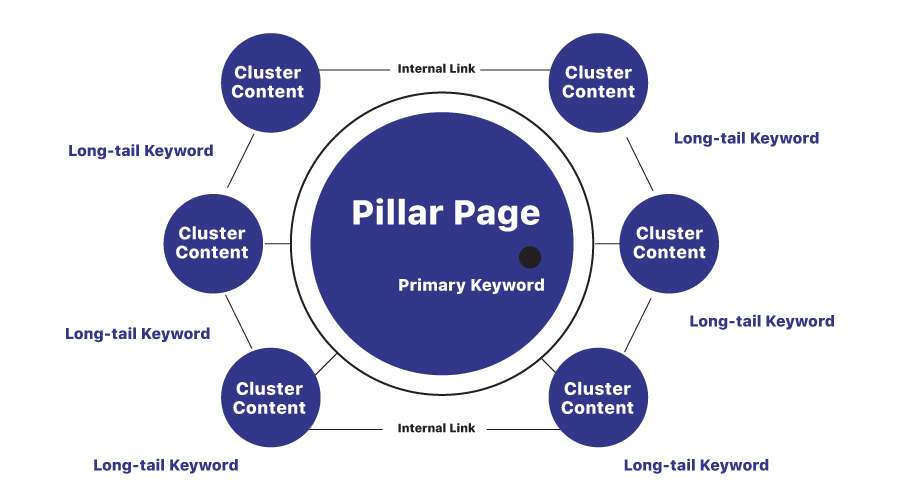10 Steps Of An SEO Strategy
- Evaluation of current SEO performance
- Analysis of competitive SEO strategy
- Setting Goals and KPIs
- Definition of Primary Keyword and Pillar Pages
- Finding Long-tail Keywords and Setting Cluster Content
- Audit site’s existing content
- Get on – page SEO
- Finding and amending technical errors
- Build off – page SEO
- Analysis and redefinition of strategy
What is SEO?
So, let’s start with the basics. Search Engine Optimization (SEO) is the process of improving the appearance of a website in Internet search results, as well as its performance in search engines such as Google. The purpose of SEO is to make a website more easily found by Internet users in search of their requested topic. A comprehensive SEO strategy can improve the appearance of the website towards search engines.
A SEO strategy can give us sufficient data and results within specific time and varies depending on the case, the industry and the company. Usually, it takes at least 4 steps to see the first significant results. Search Engine Optimization is a demanding procedure so one needs to be patient.
For a comprehensive S.E.O. strategy we will need to use tools such as Google Analytics, Google Search Console, SEMrush (with subscription), Ahrefs (with subscription), Screaming Frog . It is necessary to combine these tools to achieve better performance.
Let’s look now which steps to follow.

Evaluation of current SEO performance
To evaluate the current S.E.O. performance, a combination of the following methods is necessary.
- Use of a website audit tool to identify technical issues that may affect the website’s ranking in search engines.
- Analysis of website traffic and search engine rankings in relation to the competition and over time
- Monitoring and analysis of the backlink profile of the website. Control of the number and quality of connectors.
- Analyze the content of the website, to see if it is properly modified for the keywords we are targeting.
Analysis of competitors' SEO strategy
There are several steps to analyze the S.E.O strategy of competitors. We start of course from the recognition of the direct competitors of our website.
Analysis of the backlink profile of competitors. This will give our strategy new opportunities and ideas for backlinks and websites .
Control of on-page S.E.O. of our Competitors. It will give us the opportunity to understand the structure of the content they use and the keywords they target.
Analysis of competition marketing strategy. Monitor the type of content that competitors create and how they promote it. This can give us an idea of what works for them and what we can do differently to make our own website stand out.
And finally, of course, always monitor the ranking of our competitors. This can help us see how their SEO strategy affects search engines and the visibility of our competitors’ websites.
By analyzing the S.E.O strategy of our competitors, we manage to distinguish areas where we can improve our own SEO efforts and stay ahead of the competition.
Set goals and KPIs

The goals of a SEO project may vary depending on the specific needs and goals of a website. However, some of the most common goals include.
Increase organic traffic: This means attracting more visitors to a website through unpaid (organic) search results.
Improving the ranking of the website in search engines: Increase the visibility of the website in search engines for specific keywords or phrases.
Increase brand awareness: By appearing in search results for keywords related to their brand.
Generating leads and sales: By increasing organic traffic, a website can generate more leads.
To measure the success of SEO efforts, we can use various KPIs (Key Performance Indicators). The most common KPIs for SEO include:
Organic Traffic: This indicator measures the number of visitors who come to a website from organic search results.
Position tracking: We can track a website’s ranking for specific keywords or phrases to see if SEO efforts improve visibility.
Conversion rate: This indicator measures the percentage of visitors who take a desired action on a website, such as filling out a form or making a purchase.
Return on investment (ROI): We can calculate the ROI of your SEO efforts by comparing the profits generated by organic traffic with the cost of our SEO efforts.
By setting specific, clear and measurable goals and tracking relevant indicators (KPIs), we can measure the success of our SEO efforts and make data-driven decisions to improve our strategy.
Definition of Primary Keyword and Pillar Pages
Primary Keyword is usually the most important term for which, a web page tries to appear and rank in search results. It is often used in the title and headings of the web page, as well as in all content.
The correct and effective use of Primary Keywords is an important part of a SEO strategy, because it helps search engines understand the content of a website and determine how relevant it is to a particular search query. This, in turn, can help the website rank higher in the search results for that particular keyword, which can lead to more traffic and potentially more positive results.
Pillar Pages is a central, comprehensive resource on a specific topic. By organizing information in a clear and structured way, Pillar Pages can help search engines understand a website’s content and determine how relevant it is to a particular search query.
To optimize a Pillar Page for search engines, it is important to use Primary Keyword and related terms throughout the content of the page, in a way that is natural and useful for readers.
In conclusion, optimizing a Pillar Page for SEO involves a combination of keyword research (Primary Keywords), creating high-quality content and proper linking and formatting.

Finding Long-tail Keywords and Cluster Content
Long-tail keywords are detailed phrases that are more specific and longer than short-tail keywords. For example, a short-tail keyword can be “shoes,” while a long-tail keyword can be “women’s red high shoes.”
Using long-tail keywords is an effective strategy for search engine optimization (SEO) because they are less competitive and can be easier to rank in search results. In addition, targeting long-tail keywords can help attract better quality traffic to a website.
The concept of Cluster content for SEO includes the content organization of our website into topic- based categories. Each cluster should be centered around a specific keyword or phrase for which we want to rank in the search engines. This helps search engines understand the main topics of our website and how the pages on our website relate to each other.
To group our content, we can create a hierarchy of pages with a “Pillar – Page” main page at the top that covers the main topic, and then create subpages that cover more specific aspects of the topic. We can also use internal linkinks to connect the pages within the cluster and help search engines understand the relationship between the pages.
Some tips for grouping content
- Choose specific, long tailed keywords for each group.
- Organization of our content in a logical hierarchy with a Pillar Page and subpages (Cluster Content).
- Use internal linking to link content.
- Use header tags (H1, H2, H3) to help search engines understand the structure and hierarchy of our content.
- Frequent updating of content. In conclusion, grouping content can help optimize a website and make it easier for search engines to understand the issues and their interconnection within a website.
Audit site's existing content
SEO Audit is a process for evaluating the optimization of a website towards search engines. The goal of an SEO Audit is to identify any issues that may be preventing a website from ranking well in search engine results and make recommendations to improve the visibility and ranking of the website.
To properly perform an SEO audit, we follow these steps:
- We examine the technical issues of the website, including the structure of the website, the URLs and generally the organization of the content of the website.
- We check the on-page elements of the website’s, such as headers, titles and descriptions of the content, to make sure that they are optimized in the relevant keywords.
- Analysis of the backlink profile of the website, including the quality and relevance of the links leading to the website.
- Check the compatibility and speed of the website with mobile devices.
- Think about ways which can improve the presence of our website on social media
- We identify any other factors that may affect the ranking of the website in search engines, such as Local SEO and the presence of any “bad” or unwanted links.
By performing an SEO Audit we can identify areas for improvement and develop a strategy to increase the visibility and ranking of the website in search engine results.
Get on – page SEO
On-page SEO refers to the practice of optimizing websites in order to rank higher and gain more relevant traffic to search engines. This can be achieved by optimizing the content, code and other elements of a website.
Some of the key elements of on-page SEO include:
Title tags: It is the text that appears on the search engine results pages (SERP) as a title. It should be concise and descriptive and include the keyword that we want to target.
Meta descriptions: It’s a brief summary of the content that appears in the SERPs below the title. It should be concise and exciting and include the keyword.
Headings: Headings (H1, H2, etc.) are used to indicate the hierarchy of content and make it easier for readers and the search engine to read the page. They should include the keyword and display in a logical and hierarchical way.
Content: The content of the page should be relevant and attractive. Include the keyword, it should also be formatted in a way that is easy to understand and read by the user.
URLs: The URL of the page must be descriptive and include the keyword. It should be easy to read and understand, and it should not be too large.
Images: Images should be optimized with descriptive filenames and alt text, which can help search engines understand the content of images and improve page visibility.
By optimizing these and other elements of a website, we can improve its visibility in search results and increase the likelihood that users will click on it.
Finding & repairing technical errors (Technical SEO)
Technical SEO refers to the practice of optimizing a website for search engines from a technical point of view. Technical SEO includes a wide range of activities, such as improving the traceability of a website, optimizing its loading speed and correcting broken links.
Here are some of the most common technical issues:
Crawlability issues: If search engines have difficulty crawling the website, it can affect its ranking in the SERP. Such issues usually occur due to some broken links, bugs in robots.txt file, and duplicate content.
Loading speed issues: The common causes of slow loading speed are large image files, poorly optimized code.
Mobile-friendliness issues: With the increasing use of mobile devices to access the internet, it is important that the website is mobile-friendly. The most common issues include small text, content that cannot be played by mobile devices, and content that is larger than the screen.
Duplicate content issues: Duplicate content can confuse search engines and reduce the authority of the website.
Meta tags and header tags issues: Common issues in titles and descriptions are: Missing or duplicate tags and Tags that are not relevant or descriptive.
By identifying and fixing these technical issues, we can improve search engine rankings and provide a better user experience.
Build off – page SEO
Off-page SEO refers to the activities we can do outside of our own website to improve its ranking in search engines. Some examples of Off-page SEO activities include:
Link building: acquisition of high-quality backlinks from other websites.
Social media marketing: active presence on social media platforms.
Brand mentions: mentions of our own brand on other websites, blogs, and social media.
Local SEO: Optimize the website for local search, acquiring their Google My Business website and listing in online directories.
Overall, the goal of off-page SEO is to build the credibility and authority of our website according to the search engines’ judgement.
Analysis and redefinition of strategy
At the end of these steps, through various tools we can check the performance of our strategy. Based on the data we collect, we may need to make changes to our SEO strategy to get better results.
To redefine our strategy, we should focus on:
Target audience: We need to make sure we clearly understand who we’re trying to reach with our content.
Identify new keywords: Find new keywords that our target audience uses to search for the products or services we offer.
Update the on-page SEO: This includes optimizing the content of the website.
Stay up to date with the latest Digital News!
CONTACT US


